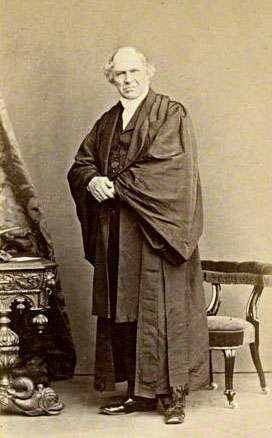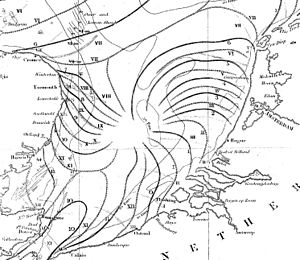William Whewell facts for kids
Quick facts for kids
William Whewell
|
|
|---|---|
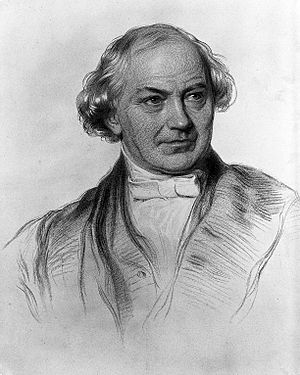 |
|
| Master of Trinity College | |
| In office 1841–1866 |
|
| Preceded by | Christopher Wordsworth |
| Succeeded by | William Hepworth Thompson |
| Personal details | |
| Born | 24 May 1794 Lancaster, Lancashire, England |
| Died | 6 March 1866 (aged 71) Cambridge, Cambridgeshire, England |
| Known for | Coining the words scientist and physicist Consilience |
| Alma mater | Trinity College, Cambridge |
| Awards | Smith's Prize (1816) Royal Medal (1837) |
| Scientific career | |
| Fields | Polymath, philosopher, theologian |
| Institutions | Trinity College, Cambridge |
| Influences | John Gough John Hudson |
| Influenced | Augustus De Morgan Isaac Todhunter |
William Whewell (born May 24, 1794 – died March 6, 1866) was an amazing English thinker. He was a polymath, which means he was an expert in many different subjects. He was also a scientist, a priest, a philosopher, and a historian of science.
Whewell was the Master of Trinity College, Cambridge, a very important position. He was known for being good at both poetry and mathematics when he was a student there.
What made Whewell special was how much he knew about. At a time when people were starting to focus on just one area of science, Whewell studied many things. He wrote about mechanics, physics, geology, astronomy, and economics. He also wrote poetry, translated books, and wrote about religion.
He even invented a math equation, the Whewell equation, which helps describe the shape of curves. He also organized thousands of people from different countries to study ocean tides. This was one of the first "citizen science" projects, where regular people help scientists. He won the Royal Medal for this work in 1837.
One of Whewell's biggest contributions was inventing new words for science. He helped other scientists find names for their discoveries. He created words like scientist, physicist, linguistics, consilience, catastrophism, uniformitarianism, and astigmatism. He also suggested words like electrode, ion, and cathode to Michael Faraday.
William Whewell died in Cambridge in 1866 after falling from his horse.
Contents
Early Life and Education
William Whewell was born in Lancaster, England. His father was a carpenter and wanted William to follow in his footsteps. However, William was very good at mathematics.
He went to Lancaster Royal Grammar School and Heversham Grammar School. His math skills earned him a scholarship to Trinity College, Cambridge in 1812. He was the oldest of seven children. His mother died when he was 13, and his father died in 1816.
Family Life
Whewell married Cordelia Marshall in 1841. Soon after, he became the Master of Trinity College. Cordelia passed away in 1855. In 1858, he married again to Everina Frances. William Whewell did not have any children.
Academic Career and Achievements
In 1814, Whewell won a special award for his poetry. He was a top math student in 1816 and became a fellow and tutor at his college.
He taught mineralogy from 1828 to 1832. Later, he became a professor of philosophy from 1838 to 1855. While he was a philosophy professor, he became the Master of Trinity College in 1841.
Studying Ocean Tides
Whewell did a lot of important work studying ocean tides. Scientists already knew about the forces that cause tides, thanks to people like Isaac Newton. But they didn't fully understand how tides moved in the oceans.
There were some tide observations for a few ports, but this information was often kept secret. A former student of Whewell's, John Lubbock, started to analyze old tide data. This helped create the first official Admiralty Tide Tables in 1833.
Whewell built on Lubbock's work. He wanted to understand tidal patterns all over the world. To do this, he needed many new observations. He started an informal network of observers. Later, the British Navy helped him organize bigger projects.
In June 1834, every Coast Guard station in the United Kingdom recorded tides every 15 minutes for two weeks. In June 1835, it became an international effort. Observers from the United States, France, Spain, and other countries joined in.
Whewell used maps to show "cotidal lines." These lines connect places where high tide happens at the same time. This helped him see how tidal waves moved through the ocean.
From his maps, Whewell predicted a place in the southern North Sea where there would be almost no tidal rise or fall. This "no-tide zone" is now called an amphidromic point. In 1840, a naval surveyor named William Hewett confirmed Whewell's prediction.
Whewell wrote about 20 papers on his tide research over 20 years. This was his most important scientific achievement. It also helped him understand how science works, which he wrote about in his book Philosophy of the Inductive Sciences.
Understanding Science and Knowledge
Whewell wrote two big books about how science develops: History of the Inductive Sciences (1837) and The Philosophy of the Inductive Sciences, Founded Upon Their History (1840). The History book looked at how each science had grown over time. The Philosophy book tried to find a general theory of knowledge based on this history.
He believed that scientific discovery involves connecting facts with new ideas. He called this "colligation of facts." For example, Johannes Kepler didn't just find new facts about planets. He connected existing facts with the idea of an ellipse to discover that planets move in elliptical orbits.
Whewell's Steps for Discovery
Whewell thought that scientific discovery happens in three steps:
- Choosing a main idea, like space or cause.
- Forming a specific concept, like a circle or a uniform force.
- Measuring things accurately.
He also described special methods for working with numbers and similarities in science. In his Philosophy of the Inductive Sciences, Whewell was the first to use the word "consilience". This term describes how different areas of knowledge can come together and support each other.
New Words for Science
As mentioned, Whewell was a master of creating new words. He often helped other scientists name their discoveries. He even came up with the word scientist in 1833. Before that, people who studied science were called "natural philosophers" or "men of science." This new word helped define a new profession.
Work in College Administration
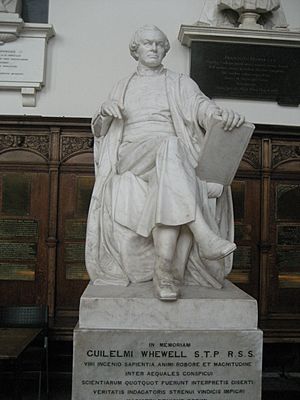
Whewell was not only a great scientist and philosopher but also a key figure in running his university and college. His first book, An Elementary Treatise on Mechanics (1819), helped change how mathematics was taught at Cambridge. His work also helped make moral and natural sciences a bigger part of the Cambridge school plan.
He was elected Master of Trinity College, Cambridge, in 1841. He held this important position until he died in 1866.
After his death, the Whewell Professorship of International Law and the Whewell Scholarships were created. These were set up using money from his will.
Interests in Architecture
Whewell was also very interested in the history of architecture. He is best known for his writings on Gothic architecture, especially his book Architectural Notes on German Churches (1830). In this book, he created clear names for parts of German Gothic churches and developed a theory about how their style changed over time.
He even paid for the construction of two new buildings at Trinity College, Cambridge. These buildings were made in a Gothic style. They were finished in 1860 and 1868 and are now called Whewell's Court.
Philosophy and Morals
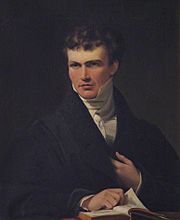
Between 1835 and 1861, Whewell wrote many books on morals and politics. His main work, Elements of Morality, was published in 1845. This book talked about the five main reasons for human actions and the basic rights of people, such as personal safety and family rights. It also discussed important virtues like justice and truth.
Whewell wrote many other popular books, including:
- Astronomy and General Physics considered with reference to Natural Theology (1833).
- Of the Plurality of Worlds (1853), where he argued against the idea of life on other planets.
- Platonic Dialogues for English Readers (1850–1861).
Whewell was one of the teachers Charles Darwin met at Cambridge. When Darwin returned from his famous Beagle voyage, Whewell encouraged him to become secretary of the Geological Society of London.
Even though Darwin used some of Whewell's ideas for his theory of evolution, Whewell himself did not support Darwin's theory. Whewell wrote a book called Indications of the Creator (1845) to argue against evolutionary ideas.
Honors and Recognitions
- He was made an honorary member of the American Academy of Arts and Sciences in 1847.
- The debating club at Lancaster Royal Grammar School is named the Whewell Society in his honor.
- A crater on the Moon is named Whewell.
- The Gothic buildings at Trinity College, Cambridge are known as Whewell's Court.
- The Whewell Mineral Gallery is in the Sedgwick Museum of Earth Sciences in Cambridge.
- A mineral called whewellite is named after him.
Images for kids
See also
 In Spanish: William Whewell para niños
In Spanish: William Whewell para niños


